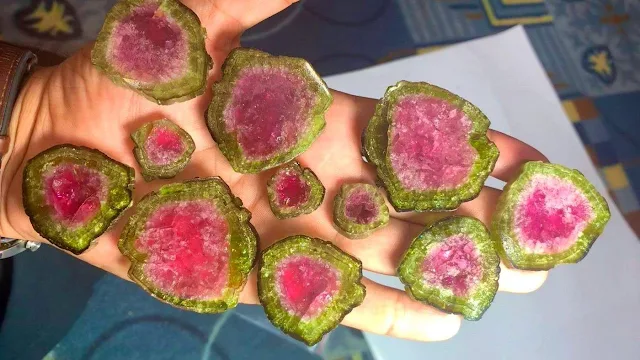What is Watermelon Tourmaline (Photos)
Watermelon Tourmaline is a distinct variety of elbaite, a lithium-rich tourmaline mineral, characterized by its notable concentric color zoning. This zoning typically consists of a pink or red core, colored by manganese, surrounded by a green outer rim, colored by iron or chromium.
Often, a pale or colorless layer separates these two colored zones, enhancing its resemblance to a slice of watermelon. Formed within pegmatite environments, this gemstone is valued for its unique appearance, relative rarity, and suitable durability for use in adornment. It is frequently prepared as polished slices to display the internal color pattern, but is also cut into cabochons and faceted gems for jewelry.
Watermelon Tourmaline is found in select locations worldwide, with the primary source being Minas Gerais, Brazil. Other notable deposits are in Nigeria, Madagascar, Afghanistan, Sri Lanka, Australia, and parts of the United States.
 |
| Natural Watermelon Tourmaline. |
What Does Watermelon Tourmaline Look Like
Watermelon tourmaline exhibits a pink core surrounded by a green outer rim, often with a pale or colorless zone between them. The pink center is typically translucent to transparent, while the green rim is translucent or occasionally opaque, depending on the specimen. Some stones show gradations or additional zoning within these colors. The gem occurs as elongated crystals or cut stones, including slices that highlight the concentric color bands.
High-clarity watermelon tourmalines with evenly distributed pink and green zones are rare and valued at $500–$600 per carat for 4–7 carat stones in European markets, according to gemologist Matthew Morrell. Cutting these stones, often into slices to emphasize the color banding, is challenging due to internal tensions that can cause cracking if not carefully managed.
 |
| Watermelon Tourmaline earrings. |
What Causes the Colors
Watermelon tourmaline colors are caused by changes in trace element concentrations during crystal growth. This variety of Elbaite displays a pink core and a green outer zone. The pink center is typically colored by manganese (Mn²⁺), while the green rim results from increased iron (Fe²⁺/Fe³⁺) content.
As the crystal grows, variations in the hydrothermal fluid’s composition produce distinct color zones that reflect changing geochemical conditions during formation.
 |
| A slice of watermelon tourmaline |
Properties & Characteristics
- Crystal Structure: It forms in the trigonal crystal system, typically as elongated, prismatic crystals with striated surfaces.
- Color Zoning: The pink center is usually translucent to transparent, and the green rim is translucent or occasionally opaque. Some specimens show gradations or additional zoning within these colors.
- Hardness: It has a Mohs hardness of 7 to 7.5, making it durable for jewelry but susceptible to scratching by harder materials.
- Specific Gravity: Ranges from 3.0 to 3.2, typical for elbaite.
- Refractive Index: Varies between 1.614 and 1.635, with birefringence of 0.018, contributing to its optical clarity.
- Luster: Exhibits a vitreous luster when polished.
- Cleavage and Fracture: Lacks cleavage but shows conchoidal to uneven fracture, requiring careful cutting to avoid cracking due to internal tensions.
- Transparency: Ranges from transparent to translucent, depending on inclusions and zoning.
- Geological Formation: Forms in lithium-rich pegmatites, where changing chemical conditions during crystal growth cause the characteristic zoning. Major sources include Brazil, Afghanistan, and Nigeria.
- Other Properties: Displays weak to moderate pleochroism, showing different shades of pink or green depending on the viewing angle. It is piezoelectric and pyroelectric, generating electric charge under pressure or heat.
These properties make Watermelon Tourmaline a popular choice for jewelry and decorative objects, prized for its unique color combination and durability.
 |
| Watermelon tourmaline slices |
Uses:
Jewelry: Watermelon tourmaline is highly prized in the jewelry industry for its attractive coloration and rarity. It is often cut into faceted gemstones and used in rings, earrings, necklaces, and bracelets. Jewelry designers appreciate its vibrant hues and natural beauty.
Decorative Objects: Watermelon tourmaline slices or polished pieces are sometimes used as decorative objects in home decor.
Gifts: Watermelon tourmaline jewelry or specimens make thoughtful and meaningful gifts for gemstone enthusiasts, collectors, or loved ones.
Chakra Healing: In some alternative healing practices, watermelon tourmaline is associated with the heart chakra and is believed to promote emotional balance, self-love, and healing of past emotional wounds.
Watermelon Tourmaline Photos
 |
| Watermelon Tourmaline slices |
 |
| Watermelon Tourmaline |
 |
| Watermelon tourmaline pendants |
 |
| Watermelon Tourmaline |
 |
| Watermelon Tourmaline: What Is Watermelon Tourmaline. A slice of watermelon tourmaline |
See also:
Tourmaline: Species and Color Varieties
Where Does Watermelon Tourmaline Come From
Rubellite - Properties, Value, Occurrence and Uses













